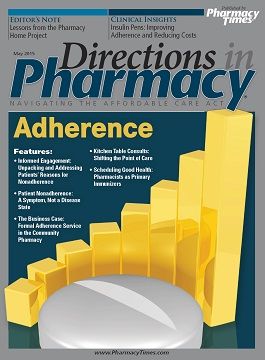Publication
Article
Pharmacy Practice in Focus: Oncology
Pharmacy Work Flow: Improving Efficiency
Author(s):
Implementing a more efficient pharmacy system can have benefits for both patients and employees.
Implementing a more efficient pharmacy system can have benefits for both patients and employees.
Every pharmacy is trying to accomplish the same things: fill prescriptions accurately and efficiently, provide high-quality patient care, and maintain a sustainable business model in which employees have good job satisfaction and customers are happy. In reality, most pharmacies operate under a model where employees spend most of their time addressing insurance issues, physician callbacks, and urgent requests. Adding more patient care services, although important, increases the workload without adding revenue. The tendency for chaos to erupt can be mitigated, however, with an improved work flow.
Many chain stores have excessive wait times and policies that prohibit pharmacists from giving immunizations and medication therapy management (MTM) interventions if they are the only one on shift. Many opportunities to improve patient care are missed because of this. Pharmacists need to intervene quickly and the moment they are needed. Improved work flow provides the time to do this.
The SmartFlow Pharmacy Workflow System creates a dynamic, as opposed to static, work flow within the pharmacy. Keys to this system are the establishment of an organized, efficient space and team members who have the appropriate skill set for their position.
Pharmacy Work Flow System
Setup
To have optimal work flow, it is important to have the right setup. This includes having an “entry station” for prescription drop-offs where the prescriptions can be placed in color-coded baskets based on priority. There should also be separate files/baskets for special cases, such as those requiring insurance resolution or physician callbacks.
Once the prescriptions are ready to be filled, they should go to a filling station that has counting trays, vials and lids, patient handouts, a built-in Health Insurance Portability and Accountability Act—compliant trash collector, and an assortment of color-coded bags (see Figure). These colored bags are used to prioritize house prescriptions awaiting pharmacist verification. The most important work flow feature of the pharmacist’s station is its proximity to the bagging area, verification rack, and counseling window. This greatly improves efficiency.

Team Members
Part and parcel of this setup is having the right staff with the appropriate skill sets. To help with efficiency, it is best to have 1 technician as the point of entry for the vast majority of prescriptions. This person should focus on prescription prioritization and entry, be able to multitask, and not be easily overwhelmed. A second technician should be positioned as the dedicated counter. This person should be able to focus on a task, assess urgency, and not be easily distracted. Ideally, they would not have to handle phone calls.
When considering pharmacists, there are generally 2 types—clinical pharmacists and production pharmacists—and very few hybrids, as these roles truly require a different personality type and skill set. Production pharmacists should handle prescription verifications, and have minimal distractions. A good production pharmacist has a sense of urgency and is satisfied with short tasks and repetition. By contrast, clinical pharmacists focus on patient care, including counseling, MTM, vaccinations, and answering patient and physician calls. They are concerned with outcomes and enjoy a more social role. The clinical pharmacist could fill in with the production side during high-volume periods. Consolidating pharmacist functions to focus solely on verification and counseling allows time for leaving the counter; it is impossible for pharmacists to do MTM cases or give immunizations if there is no time.
Another key pharmacy team position is the patient services coordinator. This person can handle third-party rejections that are not easily resolved, schedule MTM sessions, liaise with nursing homes, and help to coordinate care between physicians, the pharmacist, and patient (eg, maintain patient adherence to a medication regimen). Valuable patient service coordinators are conscientious, have excellent customer service skills, and understand the importance of follow-up.
Improving the Work Environment
Pharmacists need both production and clinical experience to excel. When work flow is properly orchestrated, there is time for MTM, adherence, and niche opportunities pharmacists were trained for but may not have been able to take advantage of because of time restraints and, in some cases, because they generate little or no reimbursement by third parties or patients. If these services can be carried out in a pharmacist’s spare time, additional revenue can be used to pay those high pharmacy salaries.
To keep the best employees at our pharmacy, we honor their time priorities. We have key employees/pharmacists who like a 3-day weekend, leaving at 3:30 pm, or having every Friday off to take care of responsibilities apart from work. With dynamic work flow staffing, more employees can spend quality time with their families or pursue personal interests. This increases employee satisfaction, allowing pharmacies to have the best employees over the long term. This, in turn, reduces employee turnover—which is a huge drain on resources.
An improved pharmacy work environment can be achieved by following a few common sense principles. Technician support staff has to be adequate and well trained, and pharmacists have to be able to perform MTM interventions, immunizations, and other activities on the fly. Pharmacists are trusted professionals because we make ourselves the most available to patients of any health care professional.
Donald Grove, RPh, has owned and operated 3 independent pharmacies in Springfield, Branson, and Warsaw, Missouri, and 3 home medical equipment stores in Osage Beach, Sedalia, and Warsaw, Missouri. An entrepreneur, Grove established the Rx/1 Services Network, a marketing company to promote independent pharmacies nationwide, and Business Prompt, a web site services and consulting company. Grove has been published in numerous industry publications and served as a guest speaker at health-related events. He developed the Smart Flow Pharmacy Workflow System to increase speed, accuracy and employee satisfaction in retail pharmacies. Grove received his BS from the University of Missouri Kansas City Pharmacy School.







